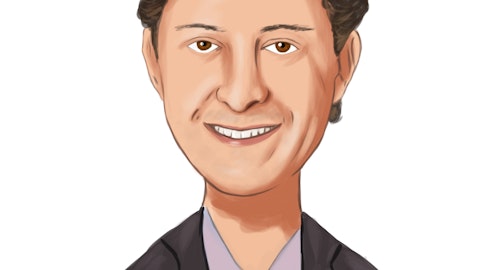Phil Lister: I would certainly agree with that, Hassan. As I look in the US, though, I think that the cost curve in the US is pretty flat. And you look at the major players in the US, they all have relatively the same size, we’re all by in growth. None of us are integrated back up into benzene, we’re producing our benzene. It feels like we’re kind of all in the same boat as far as it’s competitiveness. Natural gases, electricity is kind of the same price for everybody. The [chlorine] (ph) racket is the same for everybody. So, as I think about Europe, I think that’s where you probably see some of the biggest cost disparities between the low-cost and high-cost producers. Europe still operates some relatively small facilities. And to be honest with you, I’m surprised some of those facilities are still operating.
But again, I’m not privy to their economics, but as I look at their size — anyways, yes, so Europe, I think you’re going to see that. In Asia, you’ve got a lot of newer facilities, single line, large volume, single lines that are operating. Wanhua, I believe, probably has a — I don’t think it’s order of magnitude. They certainly have, just by virtue of their size, of their lines and so forth, I think they probably have a bit of an advantage over the other players. But I think that we shouldn’t get lost, though, necessarily on the cost of production, because as you start going downstream and as you start looking at things like our splitter in Geismar, Louisiana, you start looking at our downstream applications, going to elastomers and system houses and so forth, if those downstream businesses are being operated well and you’re focused on adding value to the molecule, I believe you’re going to make more money on your downstream business than you will on your manufacturing economics.
Both very important. Agreed. But Europe also, you do have that disparity between producers. But Europe also, in spite of some of the industrial problems and so forth, Europe also rewards innovation and rewards energy conservation, light weighting, adhesion, footwear. There’s a number of applications in Europe that — where we have some of our higher-margin businesses.
Operator: Thank you. Our next questions come from the line of John Roberts with Credit Suisse. Please proceed with your questions.
John Roberts: Thank you. Peter. Your opening comments mentioned some areas of Europe are below positive cash generation. Is that maleic anhydride? And is there anything else?
Peter Huntsman: I’d say that maleic, and again, I just got through talking about some of the better ends of our urethane businesses. There are also going to be some commodity ends of the urethane business, where we’re really struggling to get pricing up and we need to get pricing up or we need to ask ourselves if we ought to be moving that product somewhere else, to be honest with you. But as we look by and large some of the European markets, when I made the comment I had in mind, our maleic business where we are having to battle with a lot of import materials coming in and sluggish demand and some of the downstream urethane applications are still not — in my opinion, those are not volumes and margins that are sustainable.
John Roberts: Then I had thought you had already exited epoxy BLR resin that’s there. So, what else are you exiting that I thought you exited before and how much is left to go?
Peter Huntsman: Well, again, when we look at our epoxy businesses, we do continue to produce some commodity grades of epoxies and we will do that as we base load some of our facilities. Our emphasis is going to continue to be able to take that volume and moving it into higher value added components and so forth. But, yes, you do have some of the low end of your reactions — reactors that take place and your production that takes place that I consider to be commodity and that — you’re always going to be exiting the bottom end of that and pushing more volume on the upper end of that margin scale. So, not sure that it’s all necessarily, when we talked about exiting businesses, isn’t necessarily all BLR. I would just say that as we look at our capacity, availability and where we want to put our emphasis, that may be beyond just basic BLR as well.
Phil Lister: Yeah. And John, for context, I mean, BLR used to be about 50%, if you go back ten years. Today, we still have some business as Peter says, it’s about 10% of our volumes and we continue to move that down when appropriate.
Operator: Thank you. Our next questions come from the line of Salvator Tiano with Bank of America. Please proceed with your questions.
Salvator Tiano: Yes, thank you very much. So, firstly, I want to continue on that commodity epoxy discussion. And can you quantify, for example, when you said you selected some businesses in Q1, how much was that impact and what your volume growth would have been like for like without the commodity side? And as we look in the past couple of years where I think your volumes have declined by around 30%, also, can you put into context how much of that was just you walking away from low margin business versus the high-end products?
Phil Lister: Yeah. Salvatore, if you look at the Advanced Materials business, it grew in aerospace. And I think we said sales grew 6% overall year-on-year. We grew actually in automotive. We grew in the power grid area as well. So, you’re talking there just those three areas about 50% of our overall Advanced Materials business where there was growth. The commodity part was well down. And that was well down throughout the year as we did deselect some more BLR business. And year-on-year, we also moved away from some of the low-end commoditizing part of infrastructure coatings. So, if you took out some of that commodity, you would have seen growth, given our volumes into aerospace and into automotive. And I would say that quarter-on-quarter sequentially, usually you see a little bit of an uptick. We actually saw 5% growth quarter-on-quarter between 4Q and 1Q in terms of our volumes in Advanced Materials as well.
Peter Huntsman: [indiscernible] question is that, the volume that gets deselected, there’s not a lot of EBITDA that’s associated with it.
Salvator Tiano: Okay. Perfect. And since I guess you’ve already seen the value of making more downstream products here and the commodity epoxy market have been suffering for a couple of years, we’re seeing some other companies trying to shift, I guess, a little bit more downstream into epoxy systems as well. Is this something that you’re seeing in terms of competitive pressure or is the concern for you going forward?
Peter Huntsman: Well, many of our applications that would go into, for instance, the power grid and electronics, aviation and so forth, these are sold typically on a qualifying basis where you’re selling out for five to ten years on a contract. If you’re selling to the aerospace market, you’re going to be qualifying into a fighter jet project or into an airbus, a Boeing application that will be around for years to come and they typically don’t change suppliers, you don’t change specs and formulations and so forth. The other end of the business, and I kind of look beyond kind of the power and aviation, remember that this is an incredibly fragmented business, more so than any of the other businesses that we have. And you’re going to see competition coming from other competing materials, not just epoxy.
But I would think that most of our application in competition is coming from non-epoxy applications, where we’re either replacing other materials or we’re seeing other materials that will be competing against us that are not necessarily epoxy. But typically, just as a rule of thumb, the companies that I see people comparing us to in the epoxy segments are typically not the companies that we really are aggressively competing with.
Operator: Thank you. Our next questions come from the line of Kevin McCarthy with Vertical Research Partners. Please proceed with your questions.
Kevin McCarthy: Yes, thank you, and good morning, everyone. I had a question regarding MDI unit margins. So, benzene costs have been elevated a little bit north of $4 a gallon in the US lately, and your prices are rising as well. And so, if I net those two things out, when you craft your guidance of $70 million to $80 million for polyurethanes, are you baking in sequential improvement in the unit margins for MDI in terms of cents per pound? It sounds like maybe the answer is yes, but I just want to make sure I’m understanding that correctly.
Peter Huntsman: Yeah, I think, Kevin, I think that’s a correct assessment. We’re simultaneously trying to offset rising raw material prices and at the same time trying to get ahead of those prices. And I think that’s why I say we expect to see marginal price improvements and most of the improvement that we see, as I look again into the second quarter and perhaps developing the third quarter, it’s going to be — the improvement is going to be more around volume than price at this point.
Phil Lister: And, Kevin, we did see a small unit margin improvement as we moved from Q4 to Q1. And, as Peter says, we do expect a small improvement as we move from Q1 to Q2. And I would also say there’s a good focus on benzene, rightly, because that’s the largest raw material, gas remains relatively low, chlorine in general has been slightly down, and then ammonia onto nitric has been slightly down as well. So, you need to consider all of the raw materials that are flowing through into polyurethanes.
Kevin McCarthy: Very good. And then, Peter, as a second question, I think one of your five objectives for the year is to look at potential to optimize the portfolio. And in my mind, I’ve been thinking about Europe as maybe the center of that effort. I’m just tempted to ask, seems like things are improving cyclically, as you discussed in your prepared remarks. On the other hand, Europe has some problems that are arguably more structural in nature, as you’ve also addressed in the past. So, how do you put those two things on the scale? In other words, if the European assets are more fully loaded and profit is starting to come back, how do you weigh that against what may be less exciting outlook over the medium to longer term for capital deployment in the region, for example?
Peter Huntsman: Well, it’s a very good question, Kevin. It’s a rather complex one as well. So — but I mean, I’ll just briefly touch on. When margins are where they are today and uncertainty around the economy of where they are today, and I don’t want to sound — I don’t want to give false signals here, but where they are today, we certainly want to protect the balance sheet. And so this is not the time to go out and lever up the balance sheet and put uncertainty into the market. It may, and I want to emphasize what it may, it may be a time when you’re looking at industry consolidation, looking at potential mergers, bringing assets together. Typically, if you’re looking at where a lower tide is lowering the earnings of everybody, this might be an opportunity to look at those sort of structures that you typically wouldn’t look at when you’re near peak economics.
When you near peak economics, people have a tendency to stretch the balance sheet more and to be more aggressive on your M&A side. When your earnings are down, your balance sheet is to be protected, you’re going to do something that’s more capital conservative and that’s looking at potential mergers and so forth. And now, again, in saying that I don’t want to somehow signal that we’re looking to do some big merger. I’m just saying that as you go through the industry cycles that we’re going through, we’re obviously coming off of a very steep floor, we want to protect our balance sheet. We’re not going to do anything that is reckless with that balance sheet. But at the same time, we still have to be able to look at our assets. We’ve got to look at are we the best owners of these assets?
And relative to the overall value that the stock market puts on our assets, are we getting maximum value? And just because markets are down doesn’t mean we stop asking those questions.
Operator: Thank you. Our next questions come from the line of Josh Spector with UBS. Please proceed with your questions.
Josh Spector: Hi. Good morning. I wanted to follow up on polyurethanes. I think in the prepared comments, you talk about getting back to normal in that segment. I guess, what do you consider normal at this point? I guess, if you get improvement to the second half, maybe you’re run rating around $400 million, you have obviously some changes in the cost structure you alluded to, you’re doing some cost savings. I guess, what’s the bridge back to normal at this point?
Peter Huntsman: Well, I think that the bridge to get there is going to be higher volumes and it’s going to be higher pricing. But when I think of a normalized MDI market, I’m thinking of margins that are in the mid-teens, this is a business that, when it’s running on all cylinders, and that is your splitters are sold out and you’ve got strong demand, you’re probably looking at market conditions that you saw in 2022 time period of when you’re looking at the very high teens and you’re pushing 20%. But on a normalized basis, our urethane business ought to be somewhere in the mid — something just slightly north of 15%, 16%, sort of EBITDA margins. But again, we’re going to need both, again, demand and pricing to get there.
Josh Spector: That’s helpful. If I could just ask quickly just on buybacks. You didn’t do any in the quarter. I assume that’s just because the working capital flows through the quarter versus the year. But how would you expect your plans around buybacks for the rest of the year to play out?
Peter Huntsman: I think that we’ll be assessing that on a quarter-to-quarter basis. And right now we’ve — I don’t see us certainly in the second quarter and most likely in the third quarter of doing share buybacks. But again, that’s something the Board will be discussing and assessing on a quarterly basis.
Operator: Thank you. Our next questions come from the line of Matthew Blair with Tudor, Pickering, and Holt. Please proceed with your questions.


